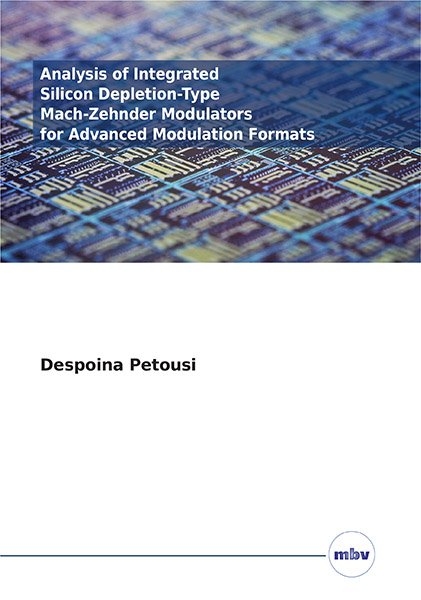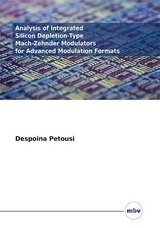Analysis of Integrated Silicon Depletion-Type Mach-Zehnder Modulators for Advanced Modulation Formats
Seiten
2017
|
1. Aufl.
Mensch & Buch (Verlag)
978-3-86387-867-2 (ISBN)
Mensch & Buch (Verlag)
978-3-86387-867-2 (ISBN)
- Keine Verlagsinformationen verfügbar
- Artikel merken
As the telecommunication industry experiences a continuous growth in data trac, there is an increasing demand for available bandwidth. To meet this requirement, complex transmitter architectures and coherent reception techniques have been developed. Towards the need for realizing compact, integrated, cost-ecient, electro-optical systems, silicon photonics has drawn significant attention. This is because low-loss waveguides, high-speed modulators and photodetectors can be integrated with electronic components on the same wafer, thus resulting in highlyoptimized architectures of electro-optical devices at a low cost.
As far as the transmitter concerns, the Mach-Zehnder modulator (MZM) is considered as a promising candidate for being used in highspeed, coherent optical systems. Its major advantage is the large optical bandwidth and the insensitivity to wavelength or temperature drifts. From the dierent modulation eects met in silicon, the plasma dispersion eect is the most prominent because of the high speed that can be achieved when utilizing carrier depletion or accumulation. The focus of the current thesis is mainly on depletion-type phase shifters that typically consist of a p-n junction inside a silicon waveguide. When applying a reverse bias voltage to the junction, the depletion of the free carriers takes place which results in a refractive index change of the optical mode.
The depletion-type phase shifters are chosen to be studied in the current thesis because they are considered to have the potentials of meeting the speed, loss and power requirements of commercial data-center and longhaul applications. Furthermore, their simplicity in fabrication and parameter tolerances make them ideal candidates for integrated transmitter architectures consisting of both the modulator and the driver.
In order to exploit the intrinsic performance limits of depletion-type phase shifters, three dierent p-n junction geometries are introduced and compared. The phase shifters are inserted into the MZM mathematical model to predict its optical output. For comparing the electrical performance of the MZMs, the traveling-wave approach is taken into account. In this approach the electrical signal on a transmission line co-propagates with the optical signal to assure high-speed operation. The comparison of the phase shifters is performed on the basis of a low driving voltage (2 V) for compatibility with the low-power driver electronics. Under this assumption, the suitability of silicon modulators for demonstrating advanced modulation formats, which is a prerequisite for meeting the increasing bandwidth demands, is explored. It is shown that although the optical performance of silicon MZMs is comparable to the technologies of lithium niobate and indium phosphide, their electro-optical performance is inferior, predominantly due to bandwidth-loss trade-os. This brings up the need for electronic-photonic integration where a dierent from the traveling-wave approach, such as the segmented driver, is implemented.
Two monolithically integrated silicon depletion-type MZMs with segmented drivers are demonstrated, the linear and the one featuring an onchip integrated digital-analog converter (DAC). The first topology outperforms in terms of extinction ratio (approximately 13.0 dB) and speed (28 and 32 Gb/s) compared to other monolithically integrated silicon OOK transmitters but at the expense of an increased power consumption (1.8 W). From the second power-ecient approach, PAM-4 at 40 Gb/s is demonstrated. The experimental results of the integrated transmitters presented here, are based on non-optimized parameters. Consequently, the modulator performance is still far from the theoretically expected.
The aim of this work is, however, to demonstrate the great potentials oered by the monolithic integration technology where the design of the modulator and the driver can be optimized simultaneously. It is expected that by using the segmented driver topology, the drawbacks of the limited extinction ratio and speed, that stem from the traveling-wave approach, can be overcome. This will enable the demonstration of advanced modulation formats by using any of the two driver architectures reported here depending on the system requirements. In this way, silicon modulators could withstand the bandwidth and cost demands and become part of future coherent optical networks.
As far as the transmitter concerns, the Mach-Zehnder modulator (MZM) is considered as a promising candidate for being used in highspeed, coherent optical systems. Its major advantage is the large optical bandwidth and the insensitivity to wavelength or temperature drifts. From the dierent modulation eects met in silicon, the plasma dispersion eect is the most prominent because of the high speed that can be achieved when utilizing carrier depletion or accumulation. The focus of the current thesis is mainly on depletion-type phase shifters that typically consist of a p-n junction inside a silicon waveguide. When applying a reverse bias voltage to the junction, the depletion of the free carriers takes place which results in a refractive index change of the optical mode.
The depletion-type phase shifters are chosen to be studied in the current thesis because they are considered to have the potentials of meeting the speed, loss and power requirements of commercial data-center and longhaul applications. Furthermore, their simplicity in fabrication and parameter tolerances make them ideal candidates for integrated transmitter architectures consisting of both the modulator and the driver.
In order to exploit the intrinsic performance limits of depletion-type phase shifters, three dierent p-n junction geometries are introduced and compared. The phase shifters are inserted into the MZM mathematical model to predict its optical output. For comparing the electrical performance of the MZMs, the traveling-wave approach is taken into account. In this approach the electrical signal on a transmission line co-propagates with the optical signal to assure high-speed operation. The comparison of the phase shifters is performed on the basis of a low driving voltage (2 V) for compatibility with the low-power driver electronics. Under this assumption, the suitability of silicon modulators for demonstrating advanced modulation formats, which is a prerequisite for meeting the increasing bandwidth demands, is explored. It is shown that although the optical performance of silicon MZMs is comparable to the technologies of lithium niobate and indium phosphide, their electro-optical performance is inferior, predominantly due to bandwidth-loss trade-os. This brings up the need for electronic-photonic integration where a dierent from the traveling-wave approach, such as the segmented driver, is implemented.
Two monolithically integrated silicon depletion-type MZMs with segmented drivers are demonstrated, the linear and the one featuring an onchip integrated digital-analog converter (DAC). The first topology outperforms in terms of extinction ratio (approximately 13.0 dB) and speed (28 and 32 Gb/s) compared to other monolithically integrated silicon OOK transmitters but at the expense of an increased power consumption (1.8 W). From the second power-ecient approach, PAM-4 at 40 Gb/s is demonstrated. The experimental results of the integrated transmitters presented here, are based on non-optimized parameters. Consequently, the modulator performance is still far from the theoretically expected.
The aim of this work is, however, to demonstrate the great potentials oered by the monolithic integration technology where the design of the modulator and the driver can be optimized simultaneously. It is expected that by using the segmented driver topology, the drawbacks of the limited extinction ratio and speed, that stem from the traveling-wave approach, can be overcome. This will enable the demonstration of advanced modulation formats by using any of the two driver architectures reported here depending on the system requirements. In this way, silicon modulators could withstand the bandwidth and cost demands and become part of future coherent optical networks.
| Erscheinungsdatum | 18.01.2018 |
|---|---|
| Verlagsort | Berlin |
| Sprache | englisch |
| Maße | 148 x 210 mm |
| Themenwelt | Technik ► Elektrotechnik / Energietechnik |
| Schlagworte | Advanced Modulation Formats • Depletion-Type Mach-Zehnder Modulators • Fiber-Optic Communications • Hochfrequenztechnik-Photonik • Limits of Depletion-Type Phase Shifters • MZMs • Optical Phase Modulation • Photonic BiCMOS • Silicon MZMs • Traveling-Wave Electrode |
| ISBN-10 | 3-86387-867-1 / 3863878671 |
| ISBN-13 | 978-3-86387-867-2 / 9783863878672 |
| Zustand | Neuware |
| Haben Sie eine Frage zum Produkt? |
Mehr entdecken
aus dem Bereich
aus dem Bereich
Kolbenmaschinen - Strömungsmaschinen - Kraftwerke
Buch | Hardcover (2023)
Hanser (Verlag)
49,99 €




